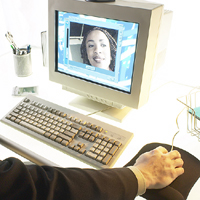
So what is the truth behind the myths of Video Conferencing and what are the arguments and barriers?
The majority of opinion about Video Conferencing is based on old experience. Those who tried Video Conferencing a number of years ago and found it to be of poor quality still hold that opinion today, even though the technology has improved considerably over the last few years.
Acceptance is also hampered by confusion between proper video tools and hobbyist toys on the Internet; the quality and user experience between these is vast. Many have seen Video Conferencing on the Internet and have been unimpressed by the quality. This is like saying, "I don't go to the cinema - I've seen one in my friend's house" because professional Video Conferencing equipment is just about as far away from Web-Conferencing as the cinema is from the 42 inch flat screen TV.
Technology is constantly changing and improving. For the first time ever, Video Conferencing has overtaken terrestrial television. We now have High Definition Video Conferencing, where most people don’t have High Definition televisions at home. Video Conferencing now gives the most life-like Conferencing experience possible, approaching the same value as face-to-face meetings.
It is commonly believed that Video Conferencing is expensive. But expensive compared to what? A photocopier? A Car? A few international flights? A Video Conferencing system can cost anything from £2,000 at entry level to £50,000 for an integrated solution. It is better to ask whether it is cost effective. Many companies are finding that their investment in Video Conferencing is paying for itself in less than 6 months if used appropriately and are seeing considerable savings on travel costs.
Many people still believe that Video Conferencing needs lots of expensive bandwidth. Over the years Video Conferencing technology has improved dramatically to send better image quality through less bandwidth. Networking technology has also developed to provide wider and wider oceans of bandwidth available at ever lowering prices. A good quality Video Conferencing system will operate comfortably at 384k, with HD needing around 1Meg, which is very much less than the bandwidth most people are able to get as ADSL in their homes. ADSL bandwidth of 2Meg is commonplace; many have 8Meg and all of this for very little money. Dedicated corporate bandwidth is available in abundance and no longer is the size of your pipe an inhibitor.
Of course, there is no substitute for a personal meeting. Video conference facilities only add an alternative way of getting in front of your colleagues and associates. We use the telephone, and Video increases the richness massively. Maybe we can get by on Video for 3 meetings out of 4. The face-to-face then becomes more meaningful; it can become a treat instead of a bind.
So what are the barriers to Video Conferencing? There truly aren’t any. And the benefits are many…
The benefits are so compelling that when companies see the technology effectively demonstrated, the question only becomes one of “when” and “what type” of equipment will be deployed – “if” just doesn’t come into it! While meeting on Video you are not spending so much money on travel, accommodation and entertainment costs. Your employees have more productive time so can do more business. Key people and key information become more accessible, enabling best use of resources.
Employees who travel a lot suffer a lot. With Video Conferencing your people will be less stressed, spend more time contributing to the success of the business and less time twiddling their thumbs in airports, train stations and traffic jams. From their perspective the work/life balance is more in equilibrium.
With phrases such as climate change, global warming and carbon footprint becoming hot topics in the business world many companies are developing or re-assessing environmental policies to improve their social responsibility. Looking at travel reduction is a vital part of this. Video Conferencing uses little energy: no petrol, diesel or aviation fuel, only a few units of electricity.
Your people can meet more often and share knowledge easily, improving internal communications and facilitating collaborative working environments. A definite plus when the trend of flexible working and home workers is on the increase.
The strategic benefits of Video Conferencing can substantially increase your competitive advantage. No matter what business you are in the success of your business is driven largely by the quality and speed of your decision-making. Decisions are not only made faster over Video, but with more consensus and agreement from everyone involved. With faster decision-making and greater consensus, new products can be brought to market quicker. In the event of a crisis, Executives can meet at short notice wherever they are located in the world for faster and more effective crisis management.
The question is no longer “should we opt for Video Conferencing” but “when”.
Sarah Leeke is marketing manager of AuDeo Systems Ltd. For more information please visit www.audeo.co.uk [1]
